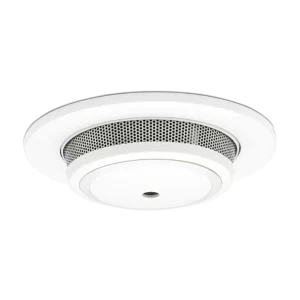Whether you’re a homeowner, a landlord, or a developer, one thing remains the same: smoke alarms are vital to your property’s safety. Properly installing and maintaining smoke alarms ensures they can do their jobs, detecting fires early and allowing inhabitants the time they need to escape should the worst happen.
Since these alarms play such a pivotal role, the New Zealand government has Building Codes that pertain to the installation, maintenance, and use of smoke alarms in NZ. In this post, we’ll explore a recent amendment made to these Codes regarding the use of photoelectric smoke alarms and what the changes might mean for you.
What are photoelectric smoke alarms?
Photoelectric smoke alarms are the latest iteration of smoke alarms used in modern buildings. Each alarm contains a light source and a sensor that picks up changes in the pattern of the light caused by smoke particles in the air. Because they pick up on particles using light, this makes these alarms particularly good at picking up smouldering fires where other alarms might miss them.
Apart from meeting the regulatory requirements we’ll outline next; there are a few additional benefits to choosing photoelectric smoke alarms over other varieties:
- Early Detection. When it comes to fire, the earlier you find it, the better. Thanks to their technology, photoelectric alarms are excellent at detecting slow-burning fires, thus providing you with enough of a warning to evacuate.
- Reduced False Alarms. No more being awoken by a screeching alarm and panicked pulse at 2 am. Photoelectric alarms are designed to minimise false alarms caused by steam or other fumes, improving the overall reliability of your alarms.

Photoelectric Smoke Alarms and the NZ Building Code
Very recently, there was an amendment to the Building Code’s Acceptable Solutions for Protection from Fire (C/AS1 and C/AS2). This amendment stated that interconnected smoke alarms should be the ongoing standard for newly-built homes or substantial renovations.
As the amendment passed in November of 2023, all affected developers, landlords, and homeowners have until November 2024 to bring their living spaces into compliance. Below, we’ve summarised some key factors of the amendment for your convenience and recommended a corresponding solution.
Long-Life Power
Smoke alarms are vitally important to everyone’s safety, so they must always be operational. Therefore, the NZ Building Code states that all installed smoke alarms must either have a 10-year long-life battery that cannot be removed or be connected to mains power.
The CAVIUS range features both options. From 10-year-powered photoelectric smoke alarms to mains-powered alarms, we have everything you need to remain compliant.
Interconnectedness is Key
One of the most interesting updates to the Code is that all smoke alarms must be interconnected. In other words, if one alarm goes off, all the alarms in the house or building go off. This ensures that even if a fire has begun in a remote part of the building, all residents will hear the alarm and evacuate as quickly as possible.
The smoke alarms can either be hard-wired or use wireless interconnection as long as they are in sync and regularly tested. Luckily, the CAVIUS range includes the Wireless Family Relay Switch, connecting your photoelectric smoke alarms to auxiliary devices that can trigger alongside the main alarm. With room for additional sounders, strobe lights, sprinklers, or even air conditioning shutdown protocols, this is the ultimate safety relay switch to have in place.
Living Spaces Take Precedence
According to the Building Code, photoelectric smoke alarms in NZ must be located in all bedrooms, living spaces, hallways, and landings within a given building. In multi-level households, there has to be at least one smoke alarm on each level.
As shown in this code, living areas and common dwelling zones take precedence over other areas of the home, such as the bathroom or laundry areas. Unfortunately, many modern smoke alarms still have outdated or clunky appearances, making them unsightly when included in every living space.
The CAVIUS range of photoelectric smoke alarms is the smallest in the world and is designed to be recessed. This ensures they are as unobtrusive as possible, blending seamlessly into your living spaces while still getting their jobs done.
Testing Capability is Needed
Finally, as with all smoke alarms that have come before, alarms still need to have a test and hush switch. This allows residents or professionals to regularly test their alarms and replace them as needed. After all, we don’t want an alarm to fail at the worst possible moment.
CAVIUS photoelectric smoke alarms recess into walls and ceilings for optimal function. Thanks to their discreet design, the entire alarm is a test and hush button, rather than having one sit on top of the alarm. This improves their visual impact while ensuring your alarms stay in working order.
Staying compliant has never been easier than with the CAVIUS range of photoelectric smoke alarms. This new amendment ensures all residents of modern buildings will be safe from the threat of fire, emphasising early detection and long-term reliability.
Stay compliant with New Zealand’s leading photoelectric smoke alarm experts.
Talk to the CAVIUS team about sourcing and installing the right smoke alarms for you. With years of experience under our belt and a wide range of fire safety solutions, we’re ready to help you bring your building up to scratch without the hassle.